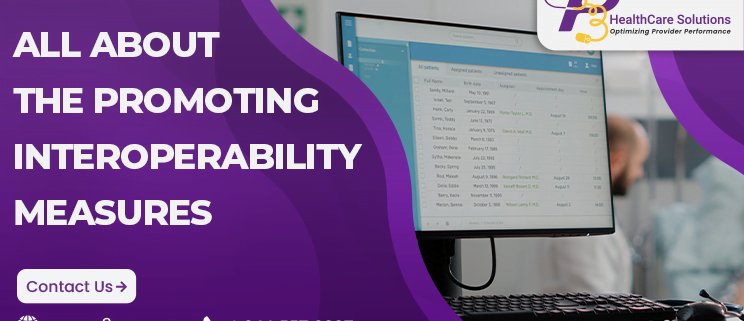MIPS 2021: All About the Promoting Interoperability Measures
MIPS
MIPS (Merit-based Incentive Payment System) is a part of the Quality Payment Program (QPP), which came into effect in 2017. Its purpose was to move the Medicare part B providers to a performance-based payment system.
It replaced three pre-existing quality-reporting programs (PQRS, VBM, and MU) and made a single system with categories, based on which a score is determined called the MIPS composite or final score.
Categories
There are four categories in the MIPS program, which are
- Quality
- Improvements Activities (IA)
- Promoting Interoperability (PI)
- Cost
Each category makes up a certain percentage of the final score. And are responsible for determining how much of a positive payment adjustment a clinician will be receiving against the performance year. Moreover, the rules and regulations regarding each category change or get updated each year as well. It is the same case for MIPS 2021.
Today we will be focusing on the Promoting Interoperability (PI) category, its basics, and which requirements clinicians need to fulfill for successful MIPS 2021 reporting.
Promoting Interoperability (PI)
This category replaces the Medicare Electronic Health Records Incentive Program (EHR and Meaningful Use Program) and composes 25% of the final score.
It deals with patient engagement and the exchange of information through Certified Electronic Health Record Technology (CEHRT), in general.
Categories and Measures
There are 11 measures in this category, which are divided into four objectives or categories.
- Electronic Prescribing (e-prescribing)
- Provider to Patient Exchange
- Health Information Exchange
- Public Health and Clinical Data Exchange
Each of the chosen measures needs to be reported for 90 consecutive days, which can be done via a MIPS Qualified Registry.
E-prescribing
This category consists of two measures.
It requires MIPS eligible clinicians to write at least one prescription and transmit it electronically through CEHRT.
This measure is worth 10 points.
Prescription Drug Monitoring Program (PDMP)
It is a bonus MIPS Quality Measure and does not need a mandatory attestation.
Moreover, it requires a MIPS eligible clinician to use data from CEHRT to examine PDMP for drug history regarding Schedule II opioids, following the applicable law.
There needs to be at least one Schedule II opioid prescribed electronically using CEHRT during the performance year to qualify for this.
It is worth 10 points. So, if you submit this measure with MIPS 2021 quality reporting data, you have a chance to gain high points in the MIPS PI category.
Provider to Patient Exchange
This category has one measure. In case you are not familiar with it, you can hire a third-party vendor, a MIPS Qualified Registry to submit their measures.
Provide Patients Access to their Healthcare Information
It requires the clinician to ensure that the patient or their representative has access to their health information. Including being able to transmit it, view it, and download it.
Any application or software can do this task. However, that tool is supposed to meet the Applications Programming Interface (API) specifications in the CEHRT.
It is worth 40 points in MIPS 2021 reporting.
Health Information Exchange
This category consists of three measures, which come as two options.
Option 1
Support Electronic Referral Loops by Submitting Health Information (Medical Records or Others)
It requires the MIPS qualified clinicians to refer at least one of their patients to another healthcare provider. Including creating a summary of their care record using CEHRT and electronically exchanging it.
If submitted this MIPS quality measure, you can receive 20 points.
Support Electronic Referral Loops by Receiving & Reconciling Health Information
This requires the clinician to be the receiver of at least one electronic summary of a care record regarding patient encounters, including a transition of care record or a referral. Or it can be the acquisition and collection of information regarding a new patient, for reconciliation of information concerning medication, medical allergy, and current list of issues.
It is worth 20 points.
Option 2
Health Information Exchange (HIE) Bi-Directional Exchange
It requires MIPS-eligible clinicians for the bi-directional exchange of information with an HIE to support transitions of care and is worth 40 points.
You can choose to attest to either option as they both hold the same points. Moreover, it is up to you to go for MIPS 2021 reporting as an individual or via a MIPS Qualified Registry.
Public Health and Clinical Data Exchange
This MIPS quality category consists of five measures.
Immunization Reporting
It requires MIPS 2021 reporting clinicians to be in active engagement with a public health agency for the submission of immunization records and to receive immunization histories from the public health immunization registry or the immunization information system (IIS).
Syndromic Surveillance Reporting
For this measure, the MIPS eligible clinician needs to submit syndromic surveillance information with a public healthcare agency, preferably from an urgent care setting.
Electronic Case Reporting
It requires the clinician to actively engage with a healthcare agency to submit data regarding reportable cases.
Public Health Registry Reporting
For this, the clinician needs to be engaging with a public agency for information submitted to public health registries.
Clinical Data Registry Reporting
For this measure, the MIPS qualified clinician needs to actively be engaging with a clinical data registry for information submission.
You can choose any two measures out of the five listed here for reporting, and they will be worth 10 points in total.
Reporting and Submission Criteria
Clinicians can collect data for their respective measures and report it by using an Electronic Health Record (EHR) that meets the following criteria:
- Technology that meets the 2015 Edition certification criteria, or
- Technology that meets the 2015 Cures Update criteria, or
- A combination of both
You can ask your MIPS 2021 Qualified Registry in this regard.
Data collection for most measures from each objective takes place for a consecutive period of 90 days.
In addition to submitting the measures, clinicians also must provide their EHR’s CMS Identification Code. However, this code must come from the Certified Health IT Product List (CHPL) and then add a “yes” for each of the following:
- The Prevention of Information Blocking Attestation
- The ONC Direct Review Attestation
- The security risk analysis measure
The data for MIPS 2021 reporting regarding each measure can be submitted by:
- The clinicians
- a representative of a practice, a virtual group, or an APM Entity
- Third-party intermediaries as a Qualified Registry
Hardship Exceptions
A clinician can apply for Promoting Interoperability Performance Category Hardship Exception in MIPS 2021 reporting. It allows them to not participate in activities from this category, which is permitted on the following grounds if you:
- Are MIPS eligible clinicians with a small practice
- Are a MIPS eligible clinician using a certified EHR Technology
- Have poor internet connectivity
- Are undergoing extreme and uncontrollable circumstances
- Lack of control over the availability of CEHRT
If your application is approved, then you will receive a 0% in the Promoting Interoperability category. Its 25% will get redistributed to another objective (or categories).
But, if you are a clinician with a special designation based on status (hospital-based) or type (physical therapist), you will not need to submit this application.
If you are a part of a group or a virtual group, all the clinicians included in the group will have to qualify for reweighing for the entire group to be reevaluated, unless they too have special status designations.
Conclusion
If you are a MIPS eligible clinician, this information will help you strategize better for the PI category. Assistance from a MIPS Qualified Registry will take all of your load to submit MIPS 2021 data timely to CMS.
You can learn more about the program here: https://p3healthcaresolutons.blogspot.com/2021/09/avoid-penalty-for-mips-2021.html
















Hello, P3care I’m your Articles reader every time I found useful information on your platform so keep it up. I need a little bit of information personal please guide me about MIPS 2021 reporting guidelines and procedures.
Promoting Interoperability and MIPS 2021 data is a way of getting high incentives and appreciation.
Overall briefly discussed steps about Promoting interoperability and MIPS 2021 reporting period.
I cannot thank you enough for such great writing and all people to their up-to-the-point reviews.
Great Information.
All About the Promoting Interoperability Measures and its basics. An overall good way to discuss steps with full data.